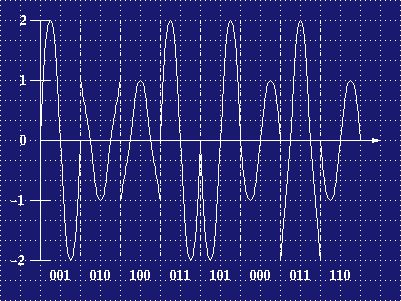
Quadrature amplitude modulation, or QAM, is a big name for a relatively simple technique. It is simply a combination of amplitude modulation and phase shiftkeying.
We'll use 2 measures of amplitude, 1 and 2, as with our AM example. We'll also use 4 possible phase shifts, as with our PSK example. Combining the two, we have 8 possible waves that we can send.
First step is to generate a table to show us which waves correspond to which binary combination. This can basically be done at random, although modem manufacturers have agreed on standards.
| Bit value | Amplitude | Phase shift |
| 000 | 1 | None (0°) |
| 001 | 2 | None (0°) |
| 010 | 1 | 1/4 (90°) |
| 011 | 2 | 1/4 (90°) |
| 100 | 1 | 1/2 (180°) |
| 101 | 2 | 1/2 (180°) |
| 110 | 1 | 3/4 (270°) |
| 111 | 2 | 3/4 (270°) |
Let's encode a big bit stream:
First, we break it up into 3-bit triads:
Now all we have to do is figure out what the resulting signal should look like. Remember that we shift each wave relative to the wave before it!

This is the technique most often used by todays modems.